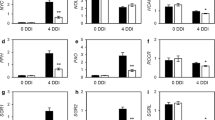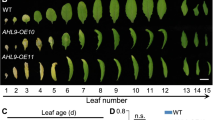Abstract
The Arabidopsis thaliana AtS40-3 gene belongs to a group of genes sharing the conserved DUF548 sequence motif with up to now unknown function. One member of this group, the barley HvS40, was shown before to play a role in regulation of leaf senescence. Similar as the barley gene, AtS40-3 is induced during senescence and is also regulated in response to dark treatment, ABA, salicylic acid and pathogen attack. By localization of the GUS fusion protein, the AtS40-3 gene was shown to encode a nucleus targeted protein. The s40-3a mutant with a T-DNA insertion in the promoter region of the gene was observed to have a staygreen phenotype. By quantitative real-time PCR analyses expression of the AtS40-3 gene in this mutant was observed to be constitutive and not induced during senescence. This coincided with WRKY53 gene expression in nonsenescent leaves and lowered expression levels of WRKY53 and SAG12 at later stages of development. While in the wildtype expression of AtS40-3 was activated by darkness, in the s40-3a mutant the expression of AtS40-3 stayed at a low level. This coincided with lower expression of the SEN1 and SAG12 genes. In another promoter mutant with a T-DNA insertion further upstream of the coding sequence the levels of AtS40-3 and SAG12 transcripts increased in parallel both in a natural light–dark regime and in darkness. The data on gene expression in promoter T-DNA insertion mutants of the s40-3 gene indicate that AtS40 regulates senescence either by modulation of WRKY53 or by activation of SAG12 independent of WRKY53.







Similar content being viewed by others
References
Ay N, Irmler K, Fischer A, Uhlemann R, Reuter G, Humbeck K (2009) Epigenetic programming via histone methylation at WRKY53 controls leaf senescence in Arabidopsis thaliana. Plant J 58:333–346
Bateman A, Durbin R (2002) QuickTree: building huge neighbour-joining trees of protein sequences. Bioinform 18:1546–1547
Becker W, Apel K (1993) Differences in gene expression between natural and artificially induced leaf senescence. Planta 189:74–79
Buchanan-Wollaston V (1997) The molecular biology of leaf senescence. J Exp Bot 48:181–199
Buchanan-Wollaston V, Ainsworth C (1997) Leaf senescence in Brassica napus: cloning of senescence related genes by subtractive hybridisation. Plant Mol Biol 33:821–834
Buchanan-Wollaston V, Page T, Harrison E, Breeze E, Lim PO, Nam HG, Lin JF, Wu S-H, Swidzinski J, Ishizaki K, Leaver CJ (2005) Comparative transcriptome analysis reveals significant differences in gene expression and signalling pathways between developmental and dark/starvation-induced senescence in Arabidopsis. Plant J 42:567–585
Cai C, Han L, Ji Z, Chen X, Chen Y (2003) SVM_prot: web-based support vector machine software for functional classification of a protein from its primary sequence. Nucleic Acids Res 31:3692–3697
Chen E, Clarke D (2002) The PEST sequence does not contribute to the stability of the cystic fibrosis transmembrane conductance regulator. BMC Biochem 3:29
Falk J, Krauß N, Dähnhardt D, Krupinska K (2002) The senescence associated gene of barley encoding 4-hydroxyphenylpyruvate dioxygenase is expressed during oxidative stress. J Plant Physiol 159:1245–1253
Gan S, Amasino RM (1997) Making sense of senescence—molecular genetic regulation and manipulation of leaf senescence. Plant Physiol 113:313–319
Glazebrook J (2005) Contrasting mechanisms of defence against biotrophic and necrotrophic pathogens. Annu Rev Phytopathol 43:205–227
Govrin EM, Levine A (2002) Infection of Arabidopsis with a necrotrophic pathogen, Botrytis cinerea, elicits various defense responses but does not induce systemic acquired resistance (SAR). Plant Mol Biol 48:267–276
Gregersen PL, Holm PB (2007) Transcriptome analysis of senescence in the flag leaf of wheat (Triticum aestivum L.). Plant Biotechnol J 5:192–206
Gregersen P, Holm P, Krupinska K (2008) Leaf senescence and nutrient remobilisation in barley and wheat. Plant Biol 10:37–49
Han L, Zheng C, Lin H, Cui J, Li H, Zhang H, Tang Z, Chen Y (2005) Prediction of functional class of novel plant proteins by a statistical learning method. New Phytol 168:109–121
Hensel LL, Grbic V, Baumgarten DA, Bleecker AB (1993) Developmental and age-related processes that influence the longevity and senescence of photosynthetic tissues in Arabidopsis. Plant Cell 5:553–564
Hinderhofer K, Zentgraf U (2001) Identification of a transcription factor specifically expressed at the onset of leaf senescence. Planta 213:469–473
Humbeck K, Quast S, Krupinska K (1996) Functional and molecular changes in the photosynthetic apparatus during senescence of flag leaves from field-grown barley plants. Plant Cell Environ 19:337–344
Kilbienski I (2007) Untersuchungen zur Funktion und Regulation des seneszenzassoziierten HvS40-Genes der Gerste (Hordeum vulgare L.) und HvS40 verwandter Gene von Arabidopsis thaliana. Mathematisch-Naturwissenschaftliche Fakultät. Christian-Albrechts-Universität, Kiel, pp 121
Kleber-Janke T, Krupinska K (1997) Isolation of cDNA clones for genes showing enhanced expression in barley leaves during dark-induced senescence as well as during senescence under field conditions. Planta 203:332–340
Krupinska K, Haussühl K, Schäfer A, van der Kooij TA, Leckband G, Lörz H, Falk J (2002) A novel nucleus targeted protein is expressed in barley leaves during senescence and pathogen infection. Plant Physiol 130:1172–1180
Lagrange T, Hakimi MA, Pontier D, Courtois F, Alcaraz, JP, Grunwald D, Lam E, Lerbs-Mache S (2003) Transcription factor IIB (TFIIB)-related protein (pBrp), a plant-specific member of the TFIIB-related protein family. Mol Cell Biol 23:3274–3286
Lichtenthaler HK (1987) Chlorophylls and carotenoids: pigments of photosynthetic biomembranes. Methods Enzymol 148:350–383
Lim PO, Kim HJ, Nam HG (2006) Leaf senescence. Annu Rev Plant Biol 58:115–136
Lim PO, Kim Y, Breeze E, Koo JC, Woo HR, Ryu JS, Park DH, Beynon J, Tabrett A, Buchanan-Wollaston V, Nam HG (2007) Overexpression of a chromatin architecture-controlling AT-hook protein extends leaf longevity and increases the post-harvest storage life of plants. Plant J 52:1140–1153
Lohmann K, Gan S, John L, Amasino RM (1994) Molecular analysis of natural leaf senescence in Arabidopsis thaliana. Physiol Plant 92:322–328
Matile P (1992) Chloroplast senescence. In: Baker NR, Thomas H (eds) Crop photosynthesis: spatial and temporal determinants. Elsevier, Amsterdam, pp 423–440
Miao Y, Laun T, Zimmermann P, Zentgraf U (2004) Targets of the WRKY53 transcription factor and its role during leaf senescence in Arabidopsis. Plant Mol Biol 55:853–867
Noodén LD (1988) Whole plant senescence. In: Noodén LD, Leopold AC (eds) Senescence and aging in plants. Academic Press, San Diego, pp 392–439
Oh SA, Lee SY, Chung IK, Lee CH, Nam HG (1996) A senescence-associated gene of Arabidopsis thaliana is distinctively regulated during natural and artificially induced leaf senescence. Plant Mol Biol 30:739–754
Oh SA, Park JH, Lee GI, Paek SH, Park SK, Nam HG (1997) Identification of three genetic loci controlling leaf senescence in Arabidopsis thaliana. Plant J 12:527–535
Otegui MS, Noh Y-S, Martinez DE, Petroff MGV, Staehelin LA, Amasino RM, Guiamet JJ (2005) Senescence-associated vacuoles with intense proteolytic activity develop in leaves of Arabidopsis and soybean. Plant J 41:831–844
Parrott D, McInnerney K, Feller U, Fischer A (2007) Steam-girdling of barley (Hordeum vulgare) leaves leads to carbohydrate accumulation and accelerated leaf senescence, facilitating transcriptomic analysis of senescence-associated genes. New Phytol 176:56–69
Pfaffl MW (2001) A new mathematical model for relative quantification in real-time RT-PCR. Nucleic Acids Res 29:e45
Saitou M, Nei N (1987) The neighbor-joining method: a new method for reconstructing phylogenetic trees. Mol Biol Evol 4:406–425
Sambrook J, Fritsch EF, Maniatis T (1989) Molecular cloning: a laboratory manual, 2nd edn. Cold Spring Harbor Laboratory, Cold Spring Harbor
Thompson J, Higgins D, Gibson T (1994) CLUSTAL W: improving the sensitivity of progressive multiple sequence alignment through sequence weighting, positions-specific gap penalties and weight matrix choice. Nucleic Acids Res 22:4673–4680
Uknes S, Mauch-Mani B, Moyer M, Potter S, Williams S, Dincher S, Chandler D, Slusarenko A, Ward E, Ryals J (1992) Acquired resistance in Arabidopsis. Plant Cell 4:645–656
Weaver LM, Gan S, Quirino BF, Amasino RM (1998) A comparison of the expression patterns of several senescence-associated genes in response to stress and hormone treatment. Plant Mol Biol 37:455–469
Acknowledgments
We thank Anke Schäfer, University of Kiel, for expert technical assistance. We also thank two anonymous reviewers for valuable comments. The German Research Foundation (DFG) is thanked for financial support (Kr13507-2).
Author information
Authors and Affiliations
Corresponding author
Electronic supplementary material
Below is the link to the electronic supplementary material.
Rights and permissions
About this article
Cite this article
Fischer-Kilbienski, I., Miao, Y., Roitsch, T. et al. Nuclear targeted AtS40 modulates senescence associated gene expression in Arabidopsis thaliana during natural development and in darkness. Plant Mol Biol 73, 379–390 (2010). https://doi.org/10.1007/s11103-010-9618-3
Received:
Accepted:
Published:
Issue Date:
DOI: https://doi.org/10.1007/s11103-010-9618-3




